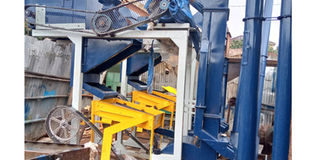Machine spares coffee farmers hours of hard labour

The coffee huller on display. Photo | Roland D. Nasasira
What you need to know:
- The combined coffee huller saves energy used on your farm because it is run by three mortars, all with a total horsepower of 50 (50HP), compared to the older hullers that had the main mortar whose horsepower was 80.
Coffee farmers in the country can breathe a sigh of relief thanks to a new machine that will now assist them in pulping and hulling coffee, a practice that is usually labour intensive.
Locally fabricated at Katwe, Hadad Ssebunza, the chief executive officer of Musa Body Machinery Uganda Limited observes that the combined coffee huller is a new design of technology that has not been on the Ugandan market.
New technology
The new combined coffee huller is a combination of three coffee huller models; Macquinal, John Gordon and Paul Kirker hullers. Technically, the combined coffee huller has a bucket elevator that picks coffee from the collection trough and transports into the upper hulling chamber.
Before the machine starts hulling, the coffee undergoes the process of de-stoning using a de-stoner to remove stones and any other unwanted rubbish before it goes into the hulling phase.
“By the time the coffee goes into the huller, it is purely clean. After hulling, it goes to the grader that removes the husks and damaged particles. From the grader, it goes to the cutter door that separates different coffee grades. This is because coffee has three grades of 12, 15 and 18,” says Ssebunza.
Ssebunza observes that the old coffee hullers mixed the three coffee grades yet grade 15 coffee is the one popularly grown in Uganda.
“This machine separates the grades three times in the cutter door. The cutter door separates the husks, grades and the damaged coffee particles. It is the newest form of technology that is locally fabricated. This means that if you experience any mechanical problem, it is easily repaired locally without halting work on your farm,” says Ssebunza.
How the machine operates
The combined coffee huller saves energy used on your farm because it is run by three mortars, all with a total horsepower of 50 (50HP), compared to the older hullers that had the main mortar whose horsepower was 80.
“Before you deposit coffee into the machine, it does not turn on the side that is not meant to run at that particular moment. It is after depositing the coffee that the machine automatically senses that it has been fed with coffee to process that it eventually turns on the other sections. If the operator is not doing anything with the machine and it is running, it shuts down key parts to save power,” he says.
He is quick to advise that before the combined coffee huller is delivered to your farm, it is crucial to train operators not only about how it works but also how it is assembled.
Advantages
According to Eliab Baryakashanga, a coffee farmer in western Uganda, the new technology in the combined coffee huller comes in at a time when post-harvest handling has been challenging especially when it comes to coffee. “Most coffee farmers dry the coffee on soil and others harvest before ripening. The fact that the machine grades the coffee and cleans it well before it is exported means the farmers will realise better quality sales and high bargaining power,” says Baryakashanga.
Production
According to Ssebunza, the production capacity of the combined coffee huller is dependent on its horsepower size. The smallest size of 50 horsepower (50HP) hulls 1.5 tonnes of coffee in one hour, the second one of 60 horsepower hulls 2.5 tonnes and the biggest with 70 horsepower hulls five tonnes per hour. The huller which costs Shs75m comes with an inbuilt fan that collects dust.
Maintenance
The machine comes with a compressor that must be blown after every operation.
It has most of its crucial parts open to allow you to see areas that need greasing but also tighten loose bolts. It does not have gears but rather comes with bearings that must also be greased to keep them in their optimal performance conditions.




